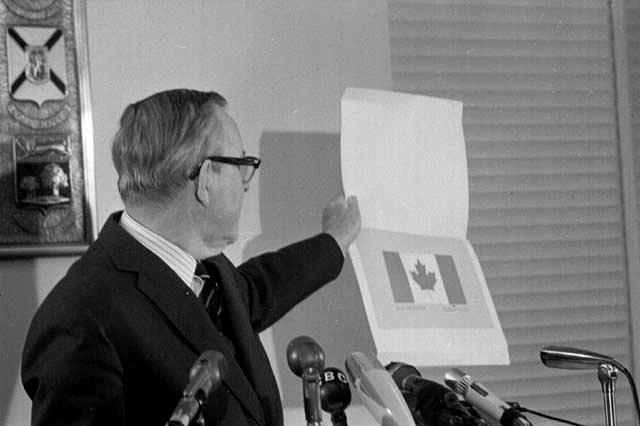In honour of Canada’s sesquicentennial this year, Sudbury.com, with the help of our resident historian Dr. Mike Commito, is going back to the archives each month throughout 2017 to highlight some important memories and events in our nation’s history. We hope to provide you with some interesting stories about our past as we collectively celebrate, and analyze, what #Canada150 means.
Canada’s maple leaf flag was officially inaugurated in ceremonies across the nation and around the world, 52 years ago today.
Parliament Hill ushered in the new era with a public gathering. Elementary schools ran the new banner up their flag poles. And Cameron Bruce of Windsor, Ont., had the distinctive honour of being the first person to raise the maple leaf at the United Nations.
It was a momentous occasion celebrated by many, but not everyone was pleased. Some, including former Prime Minister John Diefenbaker, were disappointed with the decision to introduce a new flag.
“Flags cannot be imposed, the sacred symbols of a people’s hopes and aspirations,” said Diefenbaker.
Others, simply couldn’t agree on what the new flag should look like, and a few felt that replacing the Red Ensign was a betrayal to our connection with Great Britain. But these, of course, were not new sentiments.
In fact, there had long been controversy surrounding the question of whether to adopt a distinctive Canadian flag. Prime Minister Mackenzie King tried his hand opening the dialogue in 1925, but balked at the idea when he encountered significant opposition.
Twenty years later, he floated the idea again when he tabled a joint committee made up of members of the Senate and the House of Commons to explore the option further. In total, the committee received nearly 2,500 designs from the public, with almost 67 per cent of those submissions including a maple leaf.
Among those concepts was Sudbury mayor Bill Beaton’s. His vision included a solid purple field with a golden maple leaf as the charge. Beaton chose the unique colours because since no other country in the world utilized those hues it would make Canada’s flag truly distinctive.
That’s certainly one way of viewing it.
While Beaton’s design didn’t make the cut, his passion was emblematic of the change that many were pushing for at the time. But in the end, it didn’t matter. After the committee submitted its report, King decided to not follow through on its recommendations because there was no clear consensus.
So, the flag debate went dormant, until Lester Pearson revived it in 1960. Then, leader of the opposition, Pearson believed that developing a new national flag would serve as a symbol of unity, and help bring the country together at a time when it felt like Canada was coming apart at the seams.
For him, it was imperative the country adopt its own distinctive flag, and that it was devoid of any past colonial association.
Not long after he became prime minister in 1963, Pearson appointed a special parliamentary committee to pursue finding Canada a flag of its own. It was a tall order.
Over the course of 1964, they received thousands of submissions, and even a few from famed Group of Seven painter, A.Y. Jackson. After reviewing all of the various designs, the committee painstakingly whittled it down to three options, one of which included a flag that consisted of a red maple leaf on a solid white background flanked by two red banners.
Spoiler alert: I think it’s fair to say that you already know that this was the design the committee selected to bring to the House of Commons.
But the matter was far from over. Parliament could not agree on the recommendation, and a debate ensued, lasting nearly six months. The only reason it eventually ended was because the Pearson government invoked a motion of closure in order to settle the argument with a final vote.
So, in the early morning hours of Dec. 15, 1964, the issue was resolved at last. One hundred sixty-three voted to adopt the maple leaf flag, more than enough to counter the 73 who opposed it, and the 23 members who abstained.
Two days later, it was approved by the Senate, and by the end of January, 1965, Queen Elizabeth had given it royal assent.
And so, on Feb. 15, 1965, the maple leaf first began fluttering over Parliament Hill. Ninety-eight years after Confederation, Canada had its own flag, and one that was emblematic of the country it represented.
During the flag-raising ceremony on that day in Ottawa, Pearson delivered an address that included the following words: “As the symbol of a new chapter in our national story, our maple leaf flag will become a symbol of that unity in our country without which one cannot grow in strength and purpose.”
While the adoption of the flag did not mitigate the political and social issues our country was facing, the maple leaf became a point of pride for Canadians. It became a symbol of our resiliency and distinctiveness as a nation, and a powerful emblem that people could identify with from coast to coast.
Although the maple leaf began to foster some of the national unity that Pearson was aiming for, there’s still plenty of work to be done. That being said, as we go forward in our quest to bridge the gaps and fight inequity, I can think of no better banner for Canadians to rally behind.
Mike Commito is a Canadian historian. He is currently the Applied Research Developer at Cambrian College and teaches part-time in the Department of History at Laurentian University. When he’s not doing his day job, he’s writing about hockey history, which you can find on VICE Sports, Sportsnet, and the Hockey News.
